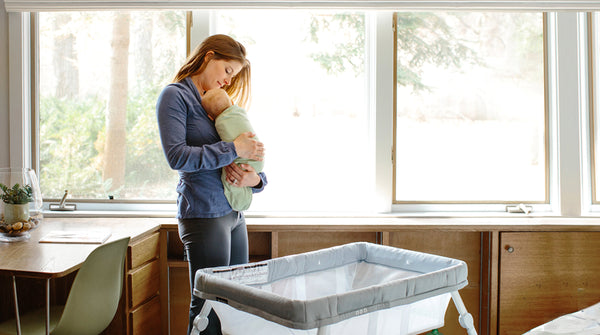Bassinet vs. Crib

We sent an email with a link to update your password
Check out our Best Sellers

Welcoming a new baby into the family means making plenty of room in your home and schedule. Between facilitating feeding times and finding the perfect additions for your nursery, parenting comes with a slew of new to-do lists. In an effort to make sure your baby grows up in the most comfortable and healthy home possible, you’ll likely find yourself weighing your options even when calculated consideration isn’t completely necessary.
Deciding between a bassinet and a crib is a lot different than deciding between canned or jarred purees. Babies spend an astounding amount of their time fast asleep, so investing in an apparatus that’s both durable and comfortable is well worth your while. The age-old debate between bassinets vs. cribs is one that remains wide open. Though it ultimately comes down to preference, there is plenty to consider before making your final purchase.
We’ll walk you through the pros, the cons, the differences, and all related questions you may have about baby bassinets and cribs. Have a specific question in mind? Use the links below to quickly navigate to an expert answer.
What are the pros and cons of a bassinet?
What are the pros and cons of a crib?
What are the differences between bassinets and cribs?
What should you look for before buying a bassinet or crib?
A bassinet is a bed specifically designed to accommodate babies from 0-months to about 4-months old. Bassinets are characterized by their basket-like construction, offering walled protection similar to cribs but on a far more minimal scale. Modern bassinets often feature a fixed frame that also has the ability to rock from side to side.
Bassinet frames are typically made of wood wicker, plastic, or metal and sit atop fixed free-standing legs. Baby bassinets tend to be lighter in weight and easier to move from room to room.
Before making a final decision, weighing the pros and cons of an item is absolutely essential to ensure you’re making the right decision.

Bassinets are also great for parents who opt to co-sleep with their child rather than letting baby sleep in a separate nursery. Bassinets are easy to bring into the bedroom and around the house when catching up on chores. No baby monitor necessary when your little one is right there with you.
A crib is another form of an infant bed engineered to accommodate newborn babies and children up to 3-years-old. Cribs feature slatted, high-sided walls that form a safety perimeter around a mini-sized mattress. Developed out of a need to keep children in their bed, the crib addressed the issue of growing infants learning how to get out of a bassinet with low sides.
Crib frames are typically made of hardwood, aluminum, or plastic. Functioning as large, stationary pieces of furniture, cribs are heavier than their bassinet counterparts.

Bassinets and cribs are both safe sleep options for newborns and young children, but the two are completely different apparatuses. To better illustrate the difference between bassinets and cribs, we’ve created an easy

|
Size & Space |
Compact, lightweight, and easily portable. Smaller in size. |
Large, heavy, and difficult to move without extra help. |
|
Cost |
More affordable since they are made with lighter, cheaper materials. |
More expensive due to their high-quality, high-strength material construction. |
|
Safety |
Safe until the prescribed weight limit is reached. A topped weight capacity creates a tipping hazard. |
Slatted high-sides protect baby from escaping or rolling outside of the crib. |
|
Parenting Style |
Parents on the go can travel easily with a portable bassinet. Bedside bassinets foster closer relationships with baby. |
Parents who want to instill a sense of self-dependence early will be better suited with a crib |
|
Durability |
Bassinets typically last up to a child’s six-month-old mark. |
Babies won’t outgrow a crib until around three years old. A convertible crib will last longer as a toddler bed. |
From an apparatus that meets current safety standards to a crib or bassinet that lives up to your functionality expectations, finding the perfect bassinet or crib takes plenty of careful consideration. Use this shopping guide to narrow down your search and give you the confidence you need to feel great about your final purchase.
The most important feature to keep a keen eye out for is the overall safety of your potential bassinet or crib. Though you’d like to believe that all items manufactured for babies are made with pristine care, there are a number of recalled and dangerous cribs and bassinets out there that ended up in shopping carts.
Safety comes first, so make sure your desired baby bassinet or crib adheres to the latest US Consumer Product Safety Commission standards. Check out the latest requirements for bassinets and cribs on CPSC.org.
Whether you’re looking to buy Guava Family’s Lotus Crib or Lotus Bassinet, knowing that both options are not only incredibly easy to assemble, but also incredibly easy to use, gives you the peace of mind you need. A bassinet or crib that is difficult to bring to life is just as difficult to pack away— make your life easy by purchasing a sleeper that a beginner builder could put together.
Don’t make the mistake of choosing an affordable crib or bassinet that sacrifices high-quality in favor of a ridiculously low price tag. If possible, find an assembled model of your desired crib or bassinet so you can see the apparatus in its full form factor. Anything that feels flimsy or breakable should be an automatic red flag.